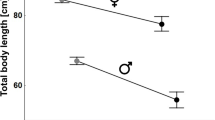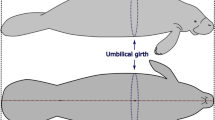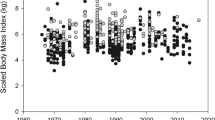Abstract
The body condition is an important metric for measuring an individuals’ morphological, biochemical, and physiological status. It may be influenced by several factors, such as the incidence of parasites, age, sex and climate. Therefore, we aimed to study the relationship between body condition, measured through the scaled-mass index, climate, altitude, sex, and age in Chiroxiphia caudata. We gathered data collected from 2001 to 2017, in five different Brazilian states: Santa Catarina, Paraná, Minas Gerais, São Paulo and Rio de Janeiro. We found that juvenile males had an increased body condition when compared to females, whereas when they reached adulthood, this relationship is inverted with females having a much higher scaled-mass index (SMI) compared to males. We also found a significant tendency of the SMI to decrease over time, and we suggest that such happening may be related to extreme and frequent events taking place in the region, such as intense droughts, habitat loss and the expansion of the agricultural land use. Finally, we found that the mean annual temperature exhibited a negative relationship with variation in SMI. Therefore, individuals coming from colder places needed to have an extra layer of fat to cope with the cold. In conclusion, our results show important within species variability, which may direct conservation effort priorities and raise consciousness for other researchers using publicly available data, since there should be an inherent spatial–temporal variability.
Zusammenfassung
Geschlecht, Alter, mittlere Jahrestemperatur und Jahr sagen die körperliche Verfassung von Blaubrustpipra Chiroxiphia caudata (Passeriformes: Pipridae) voraus.
Die körperliche Verfassung ist ein wichtiges Maß für die Ermittlung des morphologischen, biochemischen und physiologischen Zustands eines Individuums. Sie kann durch verschiedene Faktoren wie z. B. das Vorkommen von Parasiten, Alter, Geschlecht und Klima beeinflusst werden. Deshalb wollten wir bei Chiroxiphia caudata mögliche Zusammenhänge zwischen der körperlichen Verfassung, gemessen mithilfe des skalierten Masseindex, dem Klima, der Meereshöhe, dem Geschlecht und dem Alter untersuchen. Wir sammelten Daten, die zwischen 2001 und 2017 in fünf verschiedenen brasilianischen Bundesstaaten erhoben wurden: Santa Catarina, Paraná, Minas Gerais, São Paulo und Rio de Janeiro, und fanden, dass männliche Jungtiere im Vergleich zu weiblichen Tieren in besserer körperlicher Verfassung waren, während sich dieses Verhältnis im Erwachsenenalter umkehrte und die Weibchen einen wesentlich höheren relativen Massenindex (scaled-mass index, SMI) als die Männchen aufwiesen. Wir fanden außerdem eine eindeutige Tendenz des SMI, im Laufe der Zeit abzunehmen und vermuten, dass dies mit 26 extremen und häufigen Ereignissen in der Region zusammenhängen könnte, wie z. B. intensiven Dürren, Verlust des Lebensraums sowie der Ausweitung der landwirtschaftlichen Nutzung von Flächen. Schließlich stellten wir fest, dass die mittlere Jahrestemperatur einen negativen Zusammenhang mit den Schwankungen des SMI aufwies. Tiere aus kälteren Gegenden brauchten eine zusätzliche Fettschicht, um mit der Kälte fertig zu werden. Zusammenfassend lässt sich sagen, dass unsere Ergebnisse eine erhebliche Variabilität innerhalb der Art zeigten, was Prioritäten bei den Schutzmaßnahmen aufzeigen und das Bewusstsein anderer Forscher für die Verwendung öffentlich zugänglicher Daten schärfen könnte, um eine natürliche räumlich-zeitliche Vielfalt herzustellen.





Similar content being viewed by others
Availability of data and materials
The datasets used and/or analyzed during the current study are available from the corresponding author on reasonable request, as well as from the cited literature (Rodrigues et al. 2019).
Code availability
The code in R software may be provided upon request to the corresponding author.
References
Angel LP, Wells MR, Rodríguez-Malagón MA et al (2015) Sexual size dimorphism and body condition in the Australasian Gannet. PLoS ONE 10:1–16. https://doi.org/10.1371/journal.pone.0142653
Bates D, Maechler M, Bolker B, Walker S (2015) Fitting linear mixed-effects models using lme4. J Stat Softw 67:1–48. https://doi.org/10.18637/jss.v067.i01
Billerman SM, Keeney BK, Rodewald PG, Schulenberg TS (2020) Birds of the world. Cornell Laboratory of Ornithology, Ithaca, NY, USA
Briscoe NJ, Krockenberger A, Handasyde KA, Kearney MR (2015) Bergmann meets Scholander: geographical variation in body size and insulation in the koala is related to climate. J Biogeogr 42:791–802. https://doi.org/10.1111/jbi.12445
Brodin A, Nilsson JÅ, Nord A (2017) Adaptive temperature regulation in the little bird in winter: predictions from a stochastic dynamic programming model. Oecologia 185:43–54. https://doi.org/10.1007/s00442-017-3923-3
Brown DR, Sherry TW (2006) Food supply controls the body condition of a migrant bird wintering in the tropics. Oecologia 149:22–32. https://doi.org/10.1007/s00442-006-0418-z
Cheruvelil KS, Soranno PA (2018) Data-intensive ecological research is catalyzed by open science and team science. Bioscience 68:813–822. https://doi.org/10.1093/biosci/biy097
Cunha APMA, Zeri M, Leal KD et al (2019) Extreme drought events over Brazil from 2011 to 2019. Atmosphere (basel). https://doi.org/10.3390/atmos10110642
Dias RI, Manica LT, Gressler D et al (2016) Plumage coloration, body condition and immunological status in Yellow-billed Cardinals (Paroaria capitata). Ethol Ecol Evol 28:462–476. https://doi.org/10.1080/03949370.2015.1077892
do Nascimento ER, Salamuni E, Santos LJC (2016) Morphostructure of the Serra Do Mar, Paraná State, Brazil. J Maps 12:63–70. https://doi.org/10.1080/17445647.2016.1158130
Duden AS, Verweij PA, Faaij APC et al (2020) Biodiversity impacts of increased ethanol production in Brazil. Land. https://doi.org/10.3390/land9010012
Duval EH, Kapoor JA (2015) Causes and consequences of variation in female mate search investment in a lekking bird. Behav Ecol 26:1537–1547. https://doi.org/10.1093/beheco/arv110
Fick SE, Hijmans RJ (2017) WorldClim 2: new 1-km spatial resolution climate surfaces for global land areas. Int J Climatol 37:4302–4315. https://doi.org/10.1002/joc.5086
Gardner JL, Rowley E, de Rebeira P et al (2018) Associations between changing climate and body condition over decades in two southern hemisphere passerine birds. Clim Chang Responses 5:1–14. https://doi.org/10.1186/s40665-018-0038-y
Hijmans RJ (2020) raster: geographic data analysis and modeling. R package version 3.4–5
Kulaszewicz I, Wojczulanis-Jakubas K, Jakubas D (2015) Variation of the Savi’s Warbler (Locustella luscinioides) leucocyte profiles and body condition in relation to age, sex and moult. Ann Zool Fennici 52:325–338. https://doi.org/10.5735/086.052.0507
Labarbera M (1989) Analyzing body size as a factor in ecology and evolution. Annu Rev Ecol Syst 20(20):97–117. https://doi.org/10.1146/annurev.ecolsys.20.1.97
Lindström Å, Visser GH, Daan S (1993) The energetic cost of feather synthesis is proportional to basal metabolic rate. Physiol Zool 66:490–510. https://doi.org/10.1086/physzool.66.4.30163805
Mallet-Rodrigues F, Dutra R (2012a) Acquisition of definitive adult plumage in male Blue Manakins Chiroxiphia caudata. Cotinga 34:24–27. https://doi.org/10.13140/RG.2.1.4100.4963
Mallet-Rodrigues F, Dutra R (2012b) Acquisition of definitive adult plumage in male Blue Manakins Chiroxiphia caudata. Cotinga 34:24–27
Manica LT, Macedo RH, Graves JA, Podos J (2017) Vigor and skill in the acrobatic mating displays of a Neotropical songbird. Behav Ecol 28:164–173. https://doi.org/10.1093/beheco/arw143
Martín CA, Alonso JC, Alonso JA et al (2007) Sex-biased juvenile survival in a bird with extreme size dimorphism, the great bustard Otis tarda. J Avian Biol 38:335–346. https://doi.org/10.1111/j.2007.0908-8857.03811.x
McLean N, Van Der Jeugd HP, Van De Pol M (2018) High intra-specific variation in avian body condition responses to climate limits generalisation across species. PLoS One 13:1–25. https://doi.org/10.1371/journal.pone.0192401
Mercival FR, Gibbs HL, Galetti M et al (2007) Genetic structure in a tropical lek-breeding bird, the blue manakin (Chiroxiphia caudata) in the Brazilian Atlantic Forest. Mol Ecol 16:4908–4918. https://doi.org/10.1111/j.1365-294X.2007.03519.x
Mercival FR, Gibbs HL, Galetti PM (2009) Patterns of individual relatedness at blue manakin (Chiroxiphia caudata) leks. Auk 126:47–53
Milenkaya O, Weinstein N, Legge S, Walters JR (2013) Variation in body condition indices of crimson finches by sex, breeding stage, age, time of day, and year. Conserv Physiol 1:1–14. https://doi.org/10.1093/conphys/cot020
Milenkaya O, Catlin DH, Legge S, Walters JR (2015) Body condition indices predict reproductive success but not survival in a sedentary, tropical bird. PLoS One 10:1–18. https://doi.org/10.1371/journal.pone.0136582
Nadal J, Ponz C, Margalida A (2018) The effects of scaling on age, sex and size relationships in Red-legged Partridges. Sci Rep 8:1–7. https://doi.org/10.1038/s41598-018-20576-x
Neto JM, Gosler AG (2010) Variation in body condition of breeding Savi’s Warblers Locustella luscinioides: the reproductive stress and flight adaptation hypothesis revisited. J Ornithol 151:201–210. https://doi.org/10.1007/s10336-009-0444-9
Nip EJ, Frei B, Elliott KH (2018) Seasonal and temporal variation in scaled mass index of Black-capped Chickadees (Poecile atricapillus). Can Field-Naturalist 132:368–377. https://doi.org/10.22621/cfn.v132i4.2015
Owen JC, Sogge MK, Kern MD (2005) Habitat and sex differences in physiological condition of breeding Southwestern Willow Flycatchers (Empidonax traillii extimus). Auk 122:1261–1270. https://doi.org/10.1642/0004-8038(2005)122[1261:HASDIP]2.0.CO;2
Pedersen UB, Stendel M, Midzi N et al (2014) Modelling climate change impact on the spatial distribution of fresh water snails hosting trematodes in Zimbabwe. Parasit Vectors. https://doi.org/10.1186/s13071-014-0536-0
Peig J, Green AJ (2009) New perspectives for estimating body condition from mass/length data: the scaled mass index as an alternative method. Oikos 118:1883–1891. https://doi.org/10.1111/j.1600-0706.2009.17643.x
Petrie A (2020) regclass: tools for an introductory class in regression and modeling. R Package Version 1:6
Powell C (2020) CGPfunctions: powell miscellaneous functions for teaching and learning statistics. R package version 0.6.3
R Core Team (2019) R: a language and environment for statistical computing
Rainio MJ, Ruuskanen S, Eeva T (2017) Spatio-temporal variation in the body condition of female pied flycatcher (Ficedula hypoleuca) in a polluted environment. Urban Ecosyst 20:1035–1043. https://doi.org/10.1007/s11252-017-0657-2
Rezende CL, Scarano FR, Assad ED et al (2018) From hotspot to hopespot: an opportunity for the Brazilian Atlantic Forest. Perspect Ecol Conserv 16:208–214. https://doi.org/10.1016/j.pecon.2018.10.002
Ribeiro PHL, Guaraldo AC, Macedo RH, Manica LT (2019) Variation within and between courts in visual components of Swallow-tailed Manakin (Chiroxiphia caudata) display. J Ornithol 160:485–496. https://doi.org/10.1007/s10336-019-01627-0
Ribeiro PVA, Baesse CQ, de Tolentino VCM et al (2020) Haemosporidian parasites prevalence associated with physical conditioning of avian species from the Brazilian Cerrado. Ciênc Nat 42:e50. https://doi.org/10.5902/2179460x40002
Rodrigues RC, Hasui É, Assis JC et al (2019) Atlantic Bird Traits: a data set of bird morphological traits from the Atlantic forests of South America. Ecology 100:1–2. https://doi.org/10.1002/ecy.2647
Rogers CM (2015) Testing optimal body mass theory: evidence for cost of fat in wintering birds. Ecosphere 6:1–12. https://doi.org/10.1890/ES14-00317.1
Salleh Hudin N, Strubbe D, Teyssier A et al (2016) Predictable food supplies induce plastic shifts in avian scaled body mass. Behav Ecol. https://doi.org/10.1093/beheco/arw108
Saracco JF, Andrew Royle J, DeSante DF, Gardner B (2010) Modeling spatial variation in avian survival and residency probabilities. Ecology 91:1885–1891. https://doi.org/10.1890/09-0705.1
Schaedler LM, Ribeiro PHL, Manica LT (2021) Phenotype networks reveal differences between practice and courtship displays in swallow-tailed manakins. Anim Behav 171:29–39. https://doi.org/10.1016/j.anbehav.2020.11.002
Scherer AL, Scherer JFM, Petry MV, Victor H (2014) Sexual dimorphism and body condition of wintering white-rumped sandpipers in Southern Brazil Source : The Wilson Journal of Ornithology , Vol . 126 , No. 3 ( September 2014 ), pp. 553-561. Wilson Ornithol Soc Stable 126:553–561
Spaans B, Van’t Hoff K, Van Der Veer W, Ebbinge BS (2007) The significance of female body stores for egg laying and incubation in Dark-bellied Brent Geese Branta bernicla bernicla. Ardea 95:3–15. https://doi.org/10.5253/078.095.0102
Stevenson RD, Woods WA (2006) Condition indices for conservation: new uses for evolving tools. Integr Comp Biol 46:1169–1190. https://doi.org/10.1093/icb/icl052
Sun YF, Ren ZP, Wu YF et al (2016) Flying high: Limits to flight performance by sparrows on the Qinghai-Tibet Plateau. J Exp Biol 219:3642–3648. https://doi.org/10.1242/jeb.142216
Sun Y, Li M, Song G et al (2017) The role of climate factors in geographic variation in body mass and wing length in a passerine bird. Avian Res 8:1–9. https://doi.org/10.1186/s40657-016-0059-9
Verstegen JA, van der Hilst F, Woltjer G et al (2016) What can and can’t we say about indirect land-use change in Brazil using an integrated economic—land-use change model? GCB Bioenergy 8:561–578. https://doi.org/10.1111/gcbb.12270
Village A (1983) Body weights of kestrels during the breeding cycle. Ringing Migr 4:167–174. https://doi.org/10.1080/03078698.1983.9673802
Wickham H (2016) ggplot2: elegant graphics for data analysis (use R). Springer-Verlag, New York
Zima PVQ, Perrella DF, Biagolini CH et al (2017) Breeding behavior of the Atlantic forest endemic Blue Manakin (Chiroxiphia caudata). Wilson J Ornithol 129:53–61. https://doi.org/10.1676/1559-4491-129.1.53
Acknowledgements
VAP and RER thank the Coordenação de Aperfeiçoamento de Pessoal de Nível Superior and Conselho Nacional de Desenvolvimento Científico e Tecnológico for the scholarship provided during the research period, respectively. This manuscript complies with the Brazilian law of scientific research.
Funding
VAP and RER thank the Coordenação de Aperfeiçoamento de Pessoal de Nível Superior and Conselho Nacional de Desenvolvimento Científico e Tecnológico for the scholarship provided during the research period, respectively.
Author information
Authors and Affiliations
Contributions
VAP originally formulated the idea, developed the methodology and analyzed the data. VAP and RER developed and wrote the manuscript.
Corresponding author
Ethics declarations
Conflict of interest
The authors declare that they have no conflict of interest.
Ethics approval
None.
Consent to participate
All authors consented to participate in the present manuscript.
Consent for publication
All authors consented for publication of the present manuscript.
Additional information
Communicated by I. Moore.
Publisher's Note
Springer Nature remains neutral with regard to jurisdictional claims in published maps and institutional affiliations.
Supplementary Information
Below is the link to the electronic supplementary material.
Rights and permissions
About this article
Cite this article
de Souza Penha, V.A., da Silva Rodrigues, R. Sex, age, mean annual temperature and year predict the body condition in Chiroxiphia caudata (Passeriformes: Pipridae). J Ornithol 163, 445–456 (2022). https://doi.org/10.1007/s10336-021-01947-0
Received:
Revised:
Accepted:
Published:
Issue Date:
DOI: https://doi.org/10.1007/s10336-021-01947-0




